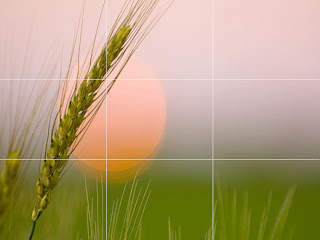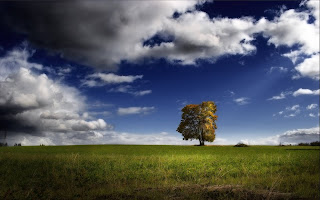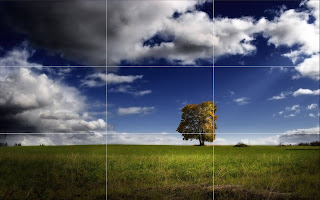Rule of thirds is a method is dividing the photograph, or
image into 3 separate sections/ thirds vertically, and then 3 thirds
horizontally, creating a grid. This allows the photographer to give his or her
photograph a unique composition. The composition basically means the position
of the main visual image, so if you are taking a picture of a flower. Then the
main visual image is the flower, the composition of the flower can be moved in
order to give the photograph its own personal image.
This is a diagram or image of the Rule of Thirds:
Here are some examples of Photographs which possess the Rule
of Third:
 This photo uses the Rule of Thirds because the main image
(the closer tree on the left) is positioned far off to the left. This helps to
interest people, as it makes the photo more interesting. A tree in the centre
of a shot will not be very interesting. It is even more interesting because the horizon also uses Rule of Thirds.
This photo uses the Rule of Thirds because the main image
(the closer tree on the left) is positioned far off to the left. This helps to
interest people, as it makes the photo more interesting. A tree in the centre
of a shot will not be very interesting. It is even more interesting because the horizon also uses Rule of Thirds.
(Above: An image from the internet which uses the Rule of Thirds. Right: The same image, but with a Rule of Thirds box which i added over the top in Photoshop, to make it easier to understand)
This is another image which uses Rule of Thirds. I particularly like this photograph because it uses it is two different places. Firstly, the main piece of grass on the left, swaying to the centre, but also the tops of other pieces of grass at the bottom, and the horizon is near the lower horizontal third. This is a very interesting photograph because of the way it uses the Rule of Thirds in multiple ways. I like the lighting as it brings out all of the detail in the grass. I also like the simplicity, as it is just a piece of grass.
(Above: An image from the internet. Right: The same image but with a Rule of Thirds diagram over the top, added in Photoshop)
Like the other photos, this also uses Rule of Thirds in More than one way. I believe that three ways have been used, the tree, the horizon and the left cloud grouping. Because of this, it helps to increase the interest in the photograph. The lighting is also good in this photograph as there is more vibrant colours around the main image, which is a tree.
(Above: An image from the internet. Right: The same image but with a Rule of Thirds diagram over the top, added in Photoshop)
I think that this is a unique photograph because of the way that it uses Rule of Thirds. I appears that it uses it four times, once for each of the thorns, and another for the branch or stem. This makes the photograph very interesting and unique. It also has good lighting as the black and white helps to interest me.
(Above: An image from the internet. Right: The same image but with a Rule of Thirds diagram over the top, added in Photoshop)
Canted Angle /Dutch Angle
The canted angle is a Photography technique when the photograph is taken on an angle to create more of an interesting and effective photograph. I like this technique and I may use it in some of my themes in this photography project. Here is an example of some Canted Angle Photography which I sourced from the internet:
Close Up Photography
Close up photography is the technique of being very close to an object whilst taking the photograph. They very often include great amounts of detail and taken on a 'macro' setting which specializes in close ups. Here are some examples of Close up photography:










